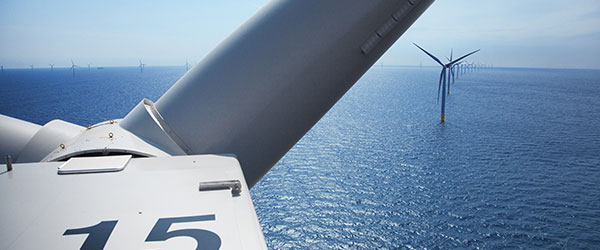
Published
- Sustainability
Harvest time at the world’s biggest offshore wind farm
Constructing and running the world’s biggest offshore wind farm takes more than technical ingenuity – financial creativity and innovative risk cover by EKN and its Danish sister agency also helps fuel green energy in the North Sea.
120 km off the Yorkshire coast lies the Hornsea Project One wind farm, with 174 wind turbines firmly anchored to the seabed in the shallow waters of the Dogger Bank area in the North Sea. Once fully operational in 2020, it will be the largest offshore wind farm in the world, providing more than 1 million UK homes with clean energy.
The unprecedented scale of constructing a windfarm further from the shore than has ever been done proved a challenge, not just from a technical point of view but from a financial one as well. It takes experience with risk assessment and structuring of complex financing deals involving billions of dollars in loans, long debt tenors and a host of financial players.
The wind turbines are manufactured by Siemens Gamesa in Denmark, while the high-voltage cables connecting the wind farm to the UK national grid were supplied by NKT’s plant in Karlskrona, Sweden. The farm is operated by Danish energy company Ørsted in cooperation with Global Infrastructure Partners (GIP), an infrastructure investment fund, with each party holding 50 percent of the operating company. GIP issued multiple bonds and other financial instruments to raise the capital required to acquire the 50-percent stake from Ørsted and to fund its share in the project.
Reducing the credit risk
The fact that Hornsea Project One secured jobs for suppliers based in Scandinavia paved the way for the participation of export credit agencies in two countries – EKF in Denmark and EKN in Sweden – by issuing guarantees that reduce the involved lenders’ credit risk.
To reduce both its risk and its total exposure to the wind sector, EKF turned to EKN for reinsurance of 25 percent of the total guarantee sum of GBP 800 million. Export credit agencies in different countries often collaborate through different forms of agreements. The most common are reinsurance agreements.
At EKN, Senior Underwriter Niclas Ringblom says the project was appealing to the agency for several reasons:
“The delivery of a 220-kV high-voltage cable system worth USD 250 million secured jobs in Karlskrona over several years. Supporting such a large project in non-carbon energy production also rhymes well with our ambition to help combat climate change.”
In 2018, EKN’s Director General was elected to participate in an operational task force which aims to coordinate and strengthen Swedish public agencies’ contribution to Agenda 2030, the UN sustainable development goals.
“We leverage our competence”
Even if the near completion of the wind farm has diminished the construction risk of the project, the operational risk in operating a wind farm 120 km offshore is still there, but Ringblom points out that it is the sort of risk that EKN is willing to take for well-structured projects.
“Plus, we are very comfortable with the extensive experience from wind power that EKF and the sponsors bring to the project,” he adds. “Also, by participating in Hornsea Project One, we leverage our competence in renewable energy, which potential Swedish suppliers may benefit from in future wind projects.”
To participating banks and investors, the commitment by export credit agencies in two countries with triple-A credit rating reduces their credit risk and provide competitive pricing. But EKN adds value to the project in other ways too, Ringblom points out:
“One of EKN’s strengths is indeed our ability to take on substantial risk. However, we view the collaboration with participating banks as a partnership in which the parties share risk assessments and project updates for the benefit of all.”
One element of risk that was removed before the project started concerns the volatility of electricity prices, which the UK government has solved by way of the Contracts for Difference (CfD) scheme, the government’s mechanism for supporting low-carbon electricity generation.
“CfD’s incentivize investment in renewable energy by providing developers of projects with high upfront capex and long lifetimes with direct protection from volatile wholesale prices,” Ringblom explains.
The over 400-square-kilometer wind farm will contribute to a significant increase in the production of clean power from offshore wind. Harvest time has come around, not just for the participating investors but for Mother Earth as well.
